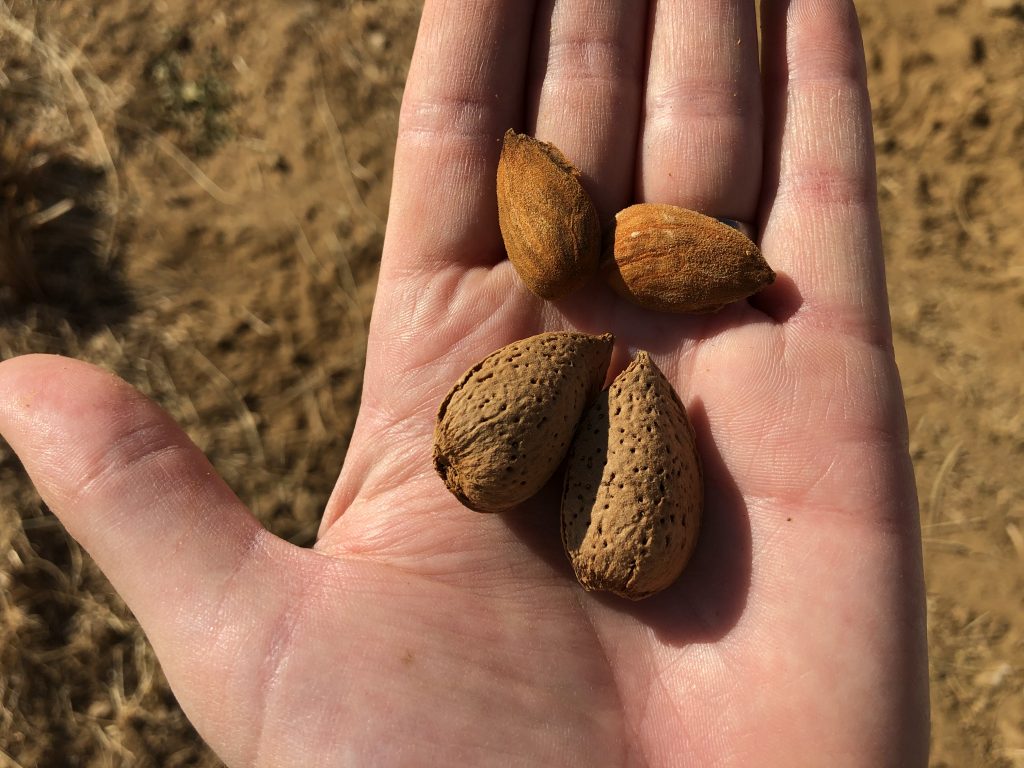
Over the past few years, I have visited several almond orchards across Spain and Portugal that are producing European cultivars of almonds. These orchards are of all shapes and planting methods, including super high density, modern high densities (115-180 trees/acre), trees with an upright, bushy, or semi-upright structure, and various pruning methods. Cultivars planted included releases from the 1970’s through releases from the past ten years. These varieties are characterized by their hard-shell/low kernel turnouts, self-fertility, later blooming, and higher fat content.
Production in these orchards is highly varied. Production within most plantings is less than what is expected in California (i.e. 2000 lbs/acre is a good yield), with ranges observed from 1000-3000 lbs/acre. It is hard to determine the reason for such a wide range in yields because of the number of variables involved. Many plantings are grown in water-limited environments (~60-80% of full irrigation), have varying development practices, as well as shorter growing seasons. Furthermore, nearly all the European cultivars have a lower crack out (~30-40% in comparison to 45-60% for California varieties), which impacts yield.
Unfortunately, direct comparisons to “California” cultivars are few. This prevents direct comparisons of bloom timing, production potential, and production operational expense. European cultivars, however, may have some characteristics that would be useful within California production systems. These characteristics include:
Self-fertility. Due to the ability for the pollen to pollinate and fertilize flowers on the same tree, these cultivars provide several advantages to most CA type orchards. This includes the planting of solid blocks, reduced bee requirements, and easier irrigation management during critical times. Beehives do seem to provide a yield response, and it is estimated that 0.5-1 hive/acre would be needed to maximize yield. The release if the California cultivars ‘Independence,’ ‘Shasta,’ and other soft-shell, self-fertile almond cultivars provide these similar benefits. Due to these features, operational expenses are reduced by 400-500 dollars/acre due to reduced beehives and harvesting expenses.
Hard-shell. Navel Orangeworm (NOW) is becoming more difficult to control. As the difficulty increases, so does the expenses. 10 years ago, winter sanitation and a single hull-split spray provided adequate control to keep damage under 2%. Today, multiple hull-split sprays, mating disruption, sterile insect technology, and other methods are being used to manage this pest and the corresponding aflatoxin issue. European varieties have a tighter shell seal, which prevents infestation. This would most likely reduce the required NOW control methods in order to deliver a crop with infestation levels under 2%. Reduced damage from leaf-footed plant bug and other true-bugs may also be possible. The closest cultivars that are grown in CA are the semi-soft shells of ‘Butte’ and ‘Padre.’ This benefit could reduce operational expenses by 75-150 dollars/acre, depending on NOW control practices.
Later bloom. Many of the European varieties bloom later than ‘Nonpareil’ and other CA varieties. This would allow expansion into areas that are more susceptible to frost. It should be noted that it is unknown why bloom is delayed, as it could be due to increased chill or heat requirements.
An increase in genetic resources. There are over 30 European cultivars available, with about 10 produced in modern orchards. Having access to these cultivars would increase the genetic resources for breeding, provide more harvest timing options, and more diversity in the product stream.
Higher fat content kernel. Most European varieties have a higher fat content than CA varieties. This provides a different flavor profile, which may be more suitable for some market conditions, fulfilling a domestic market niche.
There are some characteristics that need further research to determine suitability. These include disease susceptibility, production, and general performance. The use of these varieties would also require some modifications at the processor level as the hulling and shelling process is different (and more difficult). Due to the lack of availability within CA, they would also require a lengthy import and quarantine process to make the variety available.
There is no doubt (at least in my mind) that European varieties can produce productive orchards in California. Unfortunately, it is unknown if these orchards would be as profitable as California cultivars. Reduced operational expenses associated with pest control and pollination, as well as a reduced-price differential between CA cultivars might provide reasonable returns. This would especially be true with organic orchards or for other specialty production. As such, these cultivars should be considered for test plantings and further evaluation.


Steve Dampier
October 5, 2020Have you observed any major genetic problems like crazy top in the European varieties?
David Doll
October 7, 2020Hey Steve,
No, not yet. Some of these varieties have been around for 30-40 years with out expressing many obvious genetic defects. I believe, though, that all varieties have the tendency to express bud failure, so it may be just a matter of time. I should also add that many are grown under severe stress and have not expressed symptoms.
I should add that I have seen some obvious effects of low chill- especially this past year with a very warm January. This suggests we still have more to learn about odd chilling years/winter chill across all varieties.
David
Brent Burky
December 7, 2020Nice article David, will be interesting to see if these do ever catch on. One thing to note, a lot of these varieties actually have been imported to the US already, so if growers did want to begin trialing these, they can. In fact, I believe some of them are being trialed already in small scale trials across the state. So, the wheels are already in motion here in the US…
David Doll
December 22, 2020Brent,
Great information. Do you have a list of available varieties?
David